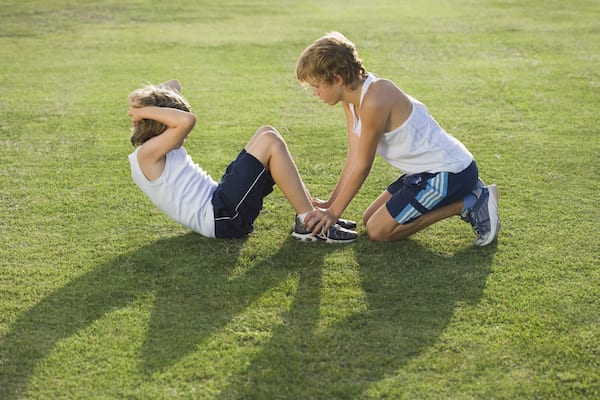Presidential Physical Fitness Test: Can You Pass It Now?

If your school days are behind you, you probably remember a gym-class rite of passage: the Presidential Physical Fitness Test.
For all of you folks lucky enough to avoid this public school tradition — which, thankfully, ended in 2012 — this battery of tests was given twice a year to schoolchildren.
Picture a horde of eight-year-olds staggering through a cross between a cattle show and the NFL combine and you’ll have a pretty good idea of what the test was all about.
I got to wondering recently: What on earth were we thinking? And how would I fare if I took the test now?
Brief History of the Presidential Fitness Test
Turns out the test can be traced all the way back to President Dwight Eisenhower. In 1953, Dr. Hans Kraus and Bonnie Prudden published a study on the fitness level of U.S. students.
In the study, they administered the Kraus-Weber Test — a pass-fail fitness test which consisted of a single rep each of six basic exercises like sit-ups and leg lifts — to students in the U.S., Switzerland, Italy, and Austria.
Nearly 60 percent of U.S. students failed one or more of the test exercises. Eisenhower was troubled — not least because the findings implied that our kids were unfit for military service, hence the slightly patriotic flavor of the whole endeavor.
In 1956, he founded the President’s Council on Youth Fitness (now known as the President’s Council on Sports, Fitness & Nutrition).
What Was the Presidential Physical Fitness Test?

The test evolved throughout the decades, but recent versions typically consisted of at least five of the following exercises:
- Sit-ups (timed for one minute)
- Push-ups (as many as possible without resting)
- Pull-ups (as many as possible) or flexed arm hang (as long as possible)
- A 30-foot “shuttle run”
- The “V-seat reach” (to gauge flexibility)
- A one-mile run
If you scored above the 85th percentile, you were eligible for the Presidential Physical Fitness Award. But is that a reliable way to gauge your fitness level?
Is the Presidential Fitness Test an Effective Measurement?
Yes and no. The good thing about this test — and any fitness test — is that it gives you something to track and improve on. In that sense, Eisenhower and Co. were onto something.
Now that I’m a fitness pro, however, I’ve come to recognize the Presidential Fitness Test as essentially flawed. Because you were pitted against other kids in your age group nationwide, success depended not just on being fit, but on being fit-ter than other students.
Through the magic of the Internet, I tracked down Debby Franzoni, the P.E. teacher who administered those tests at my elementary-school back in the ’70s and ’80s. She agreed the test had its problems.
“We were taught to teach to those who got into the [85th percentile] or above because they were the ones going on the athletic teams,” Franzoni said. Anyone below the 50th percentile “would do best in French Club.” Ouch.
But in 1987, the test changed. “Instead of being pitted against each other, kids were tested to see if they fell within a healthy standard in each component,” Franzoni says.
In other words, it was no longer about identifying exceptional performers, but about improving the health of the entire class. Her students’ average pass rate went from 50 to 90 percent — a win for the future psychological well-being of kids everywhere.
Taking the Presidential Fitness Test: Then Vs. Now

In elementary school, I swallowed the whole thing hook, line, and sinker. I even trained for it, banging out sit-ups and shuttle runs in the backyard. I was middling at dodgeball and mediocre at freeze tag, but boy, could I nail those Presidentials.
If memory serves, I bested over 90 percent of the country’s 10-year-old population with my 60-second score on the flexed-arm hang.
Nowadays, the Presidential Fitness Test has been replaced with comprehensive health and fitness programs like Let’s Move and, more recently, the Presidential Youth Fitness Program, which touts itself as “more than a test.”
But for a fitness nerd like me, the allure of those original, uncompromising fitness standards still looms large. That’s why, on a recent Sunday morning, I put on my sweats and headed to the track to put my fitness-obsessed 45-year-old body to the test (again).
I compared my results against the standards for 17-year-old boys on the chart found here.
The Results
- Pull-ups: 20 (over 85th percentile)
- V-sit-and-reach: 7.25″ (over 85th percentile)
- Sit-ups: 53 in one minute (just below 85th percentile)
- 30-foot shuttle run: 9.6 seconds (just below 50th percentile)
- One-mile run: 8:30 (far below 50th percentile)
As much as I hate to admit it, these scores are fairly accurate reflections of my athletic strengths and weaknesses. I’ve always had decent upper-body strength, and over the last few years, I’ve worked to develop good flexibility.
But running speed and explosiveness were never my strong suits and haven’t been training priorities, so those results are predictably subpar. Maybe that’s because I’ve fallen into a common fitness trap: playing to my strengths while avoiding my weaknesses.
Bottom line, the Presidential Fitness Test isn’t a foolproof measure of fitness (if I turned in these scores as a teenager, I wouldn’t get the award) but it can be a fun way to challenge yourself and see where there’s room for improvement. See you at the track.
